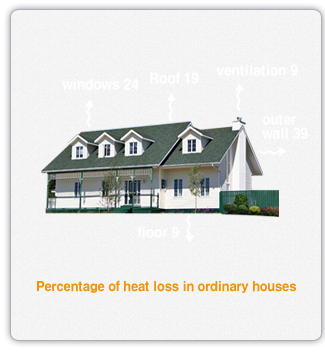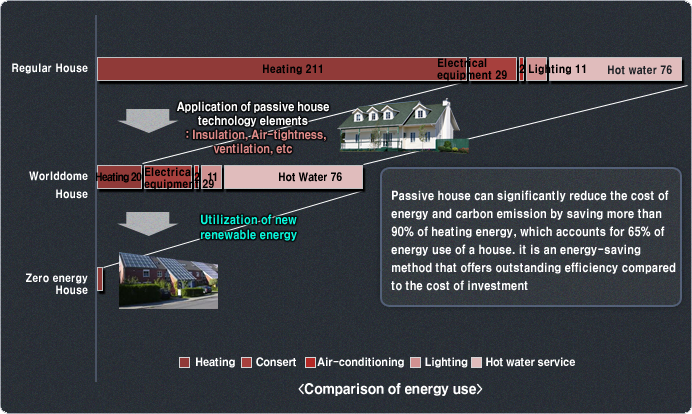WORLDDOMEHOUSE significantly reduces the amount of energy in houses by adopting passive house technology.
Passive house is a construction structure which maintains indoor temperature without using fossil fuels by prohibiting inside heat from discharging to the outside.
There are various heat sources in the building such as human bodies, mechanical and lighting devices, sun rays, etc; in order to take maximum advantage of these heat sources, insulation and air-tightness should be maintained and indoor heats should not be discharged to the outside.
This is possible by designing buildings with high insulation and air-tightness and by completely recovering the dumped heats and utilizing new renewable energy is not essential. More specifically, passive house is referred as an energy-saving construction structure whose maximum load per ㎡ for air-conditioning and heating is less than 10W. This is equivalent to less than 3ℓ annual oil use per ㎡ for air-conditioning and heating. Annual average oil use of houses in Korea is 16ℓ, which shows more than 80% of energy used can be saved and consequently, the carbon dioxide emission can be reduced.
Passive house
There is no local regulation about passive house which is a typical attempt for an energy-saving house. However, several principles have been suggested from home and abroad academic world, and a representative principle is the regulation of PHI (passiv.de) in Germany.
According to the principles of passive house, perfect harmony between all organized conditions must be secured to improve building’s energy performances and efficiency. Heat exchanger and hot water system are two most important construction technologies for passive house.
Requirements for passive house
In order to meet the requirements of passive house, complex design for the entire building is required which considers the interactions between general conditions in each part. Passive house is proven by the calculation, and necessary conditions are as follows
- Annual heating energy requirement per unit area < 15kWh(㎡a)
- Number of times of ventilation by means of pressure test n50 < 0.6h-1
- Annual primary energy requirement per unit area < 120kWh(㎡a)
General requirements for each part of the passive house
Individual general conditions required to meet the above mentioned passive house requirements standards are as follows, and even though the condition meets the individual requirement, it does not meet all the requirements of the passive house, but the complex design is required which considers the interactions.
- High Insulation – Requirements for exterior envelop insulation : U-value (0.15W/(㎡K) (sometimes, <0.10W/(㎡K)
- High air-tightness – Air-tightness : at 50 Pa of pressure difference, n50 < 0.6h-1
- High-performance window insulation
- Requirement for window insulation : Ug-value≤0.8W/(㎡K)
- Energy transmission percentage of windows and doors : g≥50%
- Requirement for window frame insulation : Uf-value ≤ 0.8W/(㎡K)
- Heat exchange ventilation – Heat recovery efficiency for ventilation : ηWRG ≥ 75%, power consumption ≤ 0.45Wh/㎡
- Minimization of heat loss caused by hot water supply
- Power saving through high-efficiency home appliances and lighting systems
WORLDDOMEHOUSE
WORLDDOMEHOUSE uses energy saving techniques except heat exchange ventilation among the general conditions for the passive houses. Requirements which are applied to WORLDDOMEHOUSE are as follows.
- High insulation
- Requirements for exterior envelop insulation : U-value (0.15 W/(㎡K) (sometimes, < 0.10 W/(㎡K))) insulation performance specific to exterior wall panel of WORLDDOMEHOUSE
- High air-tightness
- Air-tightness : At 50 Pa pressure difference, n50 < 0.6h-1
- At 50pa atmospheric pressure, 0.6 times per hour
- High-performance window insulation
- Requirements for windows and doors insulation : Ug-value ≤ 0.8 W/(㎡K)
- Energy transmission percentage of windows and doors : g ≥ 50%
- Requirements for window frame insulation : Uf-value ≤ 0.8 W/(㎡K)
- High-performance window construction
- Minimization of heat loss caused by hot water supply
- Power saving through high-efficiency home appliances and lighting systems
- Application of grade 1 high-efficiency home appliances









